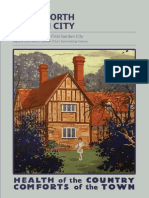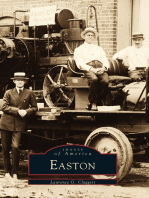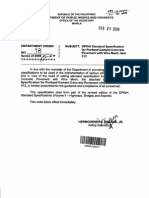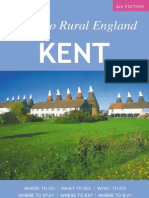Hist Central Park
Hist Central Park
Uploaded by
She TimbancayaCopyright:
Available Formats
Hist Central Park
Hist Central Park
Uploaded by
She TimbancayaOriginal Description:
Copyright
Available Formats
Share this document
Did you find this document useful?
Is this content inappropriate?
Copyright:
Available Formats
Hist Central Park
Hist Central Park
Uploaded by
She TimbancayaCopyright:
Available Formats
Central Park
A Hundred Years
discover Dartford
contents
Introduction
History of Central Park
Map of Central Park
Life story of Lieutenant-Colonel CN Kidd
Central Park today
Getting here
Expansion of Central Park
1
2
7
10
12
13
14
introduction
Central Park celebrated its one hundredth anniversary
on 7 June 2005, having been opened to the public for
the first time on that day in 1905. It is Dartfords
largest recreation ground. Central Park has seen many
changes and additions over the years but it is still
open for the enjoyment of the inhabitants of
Dartford as its donor, Lieutenant-Colonel C.N. Kidd,
intended all those years ago.
1 Central Park A Hundred Years
history of Central Park
history of Central Park
The origins of Central Park date back to 1903 when
Lieutenant-Colonel Charles Newman Kidd J.P. offered
five acres (two hectares) of meadows to the town to
be used as an area of recreation. This was sited
approximately in the centre of the park as we know it,
and was entered from Lowfield Street.
Plaque
commemorating
the donation of
the original
Central
Recreation
Ground.
Lieutenant-Colonel Kidd believed that the Recreation
Ground could be self-supporting if the Council was to
charge admission for entertainment on 12-13 days a
year. If the Council did not want to accept the gift, he
was prepared to hand over a cheque representing the
value of the land instead, to be spent for the good of
the townsfolk.
View of lily pond
in Bank House
extension,
looking south
towards original
Central
Recreation
Ground, 1917
Fortunately the Dartford Urban District Council
accepted the gift of land and in June 1905 the Central
Recreation Ground, as it was then called, was
ceremonially opened to the public. The procession led
from outside the Councils offices above Martins Bank
Central Park A Hundred Years 2
history of Central Park
(now Barclays Bank), Lowfield Street, along to the park
entrance in Lowfield Street where Lieutenant-Colonel
Kidd was presented with a silver key to unlock the
gates. The Dartford Volunteer Silver Band performed a
selection in the bandstand. This was followed by
speeches which many people in the audience could
not hear. That evening a complimentary dinner was
held at the Bull Hotel in honour of Lieutenant-Colonel
Kidd.
Band stand in
Central
Recreation
Ground, prior to
1910
The park was enclosed by iron railings and included
broad paths and grassed areas, with plants and shrubs
planted at various locations. In addition to the
bandstand, facilities included a renovated football
grandstand, a shelter and public conveniences.
In 1906 the old town pump, originally sited in the
High Street, was placed in the Recreation Ground
where it stood until 1953.
The old town pump
which stood in
Central Park from
1906 until 1953
3 Central Park A Hundred Years
history of Central Park
In 1910 Bank House on the High Street was converted
into Council Offices and much of its garden, complete
with ornamental pond, was added to the Central
Recreation Ground, with access from the High Street
along an alleyway.
In 1915 the Council purchased 16 acres (6.5 hectares)
of meadows bordering the River Darent and
stretching southwards to the area now covered by the
running track. This area, known as the Central Park
Extension, first opened to the public in May 1916 but
closed about one month later due to lack of staff. It
opened again in 1921, having gained a lake. In 1927 it
was closed again, levelled and reseeded with grass
before opening for good in May 1931.
German field
gun presented to
Dartford in 1919
by the Australian
government
During the First World War a military camp, mostly
consisting of tents, was set up in the park. In 1919 two
German field guns were put on display in the park;
one presented by the Royal West Kent Regiment and
the other by the Australian government in thanks for
the hospitality extended to their soldiers at the
Orchard Hospital. The guns were donated for scrap in
1940 to help the war effort during the Second World
War. A First World War tank is also said to have been
displayed here but was removed in the 1930s.
In May 1922 the war memorial, surmounted by the
statue of a British soldier, was unveiled. The following
year one of the stone arches from the medieval town
bridge was rebuilt across a small stream in the park
where it remains to this day, although the stream now
runs underground.
Central Park A Hundred Years 4
history of Central Park
Part of medieval
town bridge,
rebuilt in Central
Park in 1923
In 1926 Market Street was constructed through part of
the grounds behind Bank House in order to give
greater access to the park and library.
In 1927, 16 year old Lawrence Hills, who went on to
found the Henry Doubleday Research Association (the
leading organic gardening society in Britain), started
his gardening career with some voluntary work in
Central Park.
In 1928 the base of a gateway from a Roman Villa in
Farningham was reconstructed using original
materials. A path was also laid, using Roman cobbles
from the foot of East Hill. The gateway is still in place
but most of the cobbles were removed in 1968.
In the late 1920s the market bell and its supporting
structure, which had stood at the High Street entrance
to the park, were re-erected at the boundary of the
Extension and the original 1905 Recreation Ground.
Unfortunately the bell was stolen in 1965.
In March 1933 the Dartford Harriers began their long
association with Central Park when the Council agreed
to mark out a grass track for them at the southern end
of the park.
From 1936 Central Park became the annual venue for
a fund-raising carnival for the Livingstone Cottage
5 Central Park A Hundred Years
history of Central Park
Hospital. This was the origin of the Dartford Festival
which is still held annually in Central Park.
In July 1937 a scheme to build a very large Municipal
Building in Central Park, near the Library, was dropped
due to public objection. In the same year a bowling
green and a childrens paddling pool appeared.
The market bell
and gates were
moved to
Central Park in
the late 1920s
In 1938 the Princes Road entrance to the park was
constructed. Also in 1938 public air raid trenches were
dug near the Lowfield Street entrance. The following
year they were concreted and turfed over to give
extra protection and comfort.
In 1939 land was acquired next to the park for
building the first of several greenhouses.
During the Second World War, the Government
ordered that one of the footpaths in the park should
be specially coated to render it less visible to enemy
aircraft. At this time the park was often used by
American and Canadian servicemen as a venue for
playing baseball.
In 1949 an open air stage was created on the island of
the paddling pool. In the 1950s a white concrete stage
was built nearer to the Library but was demolished for
safety reasons in 1979.
(continued after Central Park map)
Central Park A Hundred Years 6
map of Central Park
map of Central Park
Central Park
Market Street
War memorial
Dartford Library and Museum
Formal gardens and
medieval bridge
Rose
garden
Childrens
play area
To Lowfield Street
River
Darent
To Lowfield Street
Public
conveniences
Running track
To Princes Road
7 Central Park A Hundred Years
Central Park A Hundred Years 8
history of Central Park
history of Central Park (continued)
In the 1950s a carpet bed was constructed on which
floral displays could be laid out to mark various events
or anniversaries. This is still done today.
Floral carpet
bed, Central
Park, 1967
In July 1960 a special garden for the use of blind
people was paid for by Dartford and District Round
Table. The Dartford Harriers grass running track was
replaced in 1968 by a cinder track.
Garden for the
Blind, opened in
1960
During the early 1970s all of the ornamental ponds
had to be filled in due to seepage problems.
In 1984 Zola Budd ran her first UK race at the Central
Park running track. Money gained by the Dartford
Harriers from selling coverage rights to the media was
put towards an all-weather synthetic running track
which was laid in 1987.
A new childrens play area opened in May 1996.
Central Park faces an interesting future and the
surrounding debate has shown that it truly plays a
central part in the life of the people of Dartford.
9 Central Park A Hundred Years
life story of Lieutenant-Colonel CN Kidd
life story of Lieutenant-Colonel
CN Kidd
Charles Newman Kidd was born in 1845 and served
his apprenticeship at Messrs Holmes and Styles
Medway Brewery in Maidstone. He came to Dartford
in 1868 when he purchased the Miskin family
brewery, renaming it Kidds Steam Brewery. This stood
on the site now occupied by the Co-operative
Supermarket in Hythe Street.
LieutenantColonel Charles
Newman Kidd
Soon after arriving in Dartford, he showed an interest
in the local government of the town. In 1870 he was
elected to the Local Board of Health (the nearest
equivalent to the Council at that time). In 1882 he was
elected chairman of the Local Board and was re
elected year after year. Even when the Local Board was
superseded by Dartford Urban District Council in
1894, Kidd continued to be elected as chairman every
year until his retirement in 1903.
He was also Chairman of the local bench of
magistrates and this led to the strange situation of a
man who owned a brewery and numerous public
houses fining or even sentencing people to hard
labour for drunkenness!
In addition to his brewery, between 1886 and 1903
Kidd also owned a brick-making business in
Shepherds Lane. This was situated in the area now
Central Park A Hundred Years 10
life story of Lieutenant-Colonel CN Kidd
occupied by Sullivan Close, between Somerset Road
and Christchurch Road. In 1904 Kidd donated an
adjoining plot of land for the building of Christ
Church.
Kidd was a member of the Dartford Volunteer Rifle
Corps (a forerunner of the Territorial Army) and was
commander of the Corps from 1872 until 1884. In that
year he was promoted from Captain to Major and, at
some point in the next four years, to LieutenantColonel. When he donated the land for Central Park,
he also gave an adjoining piece of land to the Corps
for a purpose-built drill hall.
Drill Hall, Central
Park
Lieutenant-Colonel Kidd died at his home, West Hill
House (now the Masonic Hall), on Friday 5th October
1917, aged 72. His funeral service took place in Holy
Trinity Church on Monday 8th and he was then buried
in the East Hill Cemetery on the Brent.
11 Central Park A Hundred Years
Central Park today
Central Park today
Central Park comprises some 27 acres (11 hectares)
ranging from formal gardens near to the Town Centre,
through ornamental areas to informal open space at
the southern end towards Princes Road. The River
Darent runs along the eastern boundary.
Each summer at least 45,000 plants are used to create
colourful bedding displays. These formal gardens are
complimented by a newly redesigned rose garden
and pergola which will prove to be quite spectacular.
Central Park has a large children's playground which is
extremely popular with local children and visitors
alike.
The informal areas of the park include large stretches
of grass, junior football pitches and walks by the river.
The southern end is home to the Dartford Harriers
running track and pavilion. Central Park hosts
numerous events, particularly in summer, including
the popular Dartford Festival weekend in July. There
are public conveniences and a small car park near the
Cranford Road entrance at the southern end of the
park (next to Fairfield Pool), and conveniences just
outside the park in Market Street. Central Park is
monitored by CCTV. For further information,
telephone the Civic Centre or e-mail
parks@dartford.gov.uk.
The rose garden
Central Park A Hundred Years 12
getting here
getting here
The main entrance to Central Park is in Market Street,
next to the Museum and Library building.
BY FOOT: The Market Street entrance to Central Park
is a one minute walk from the High Street. Pedestrian
access is also available from Lowfield Street, Cranford
Road and Princes Road.
BY CAR: Any of the Town Centre car parks are a short
walk from the main entrance to Central Park in Market
Street. Limited parking is available at the Cranford
Road entrance.
BY RAIL: Tel. 0845 748 4950 Web: www.nationalrail.co.uk
Dartford is served by trains from various London
stations: Charing Cross, Cannon Street, Waterloo East,
London Bridge and Victoria. The North Kent Line also
runs from Dartford to the Medway towns and the
Kent Coast. Central Park is a 10 minute walk from
Dartford Station.
BY TAXI: For any visitors arriving by rail, there is a taxi
rank outside Dartford Station.
BY BUS: Tel. 0870 608 2 608; Web:
www.arriva.co.uk/southerncounties
13 Central Park A Hundred Years
expansion of Central Park
expansion of Central Park
In the year of its centenary, Central Park is set to
double in size as a result of the purchase of
neighbouring Acacia Hall and its grounds by Dartford
Borough Council from the pharmaceutical company
GlaxoSmithKline. This will increase the size of Central
Park from 27 acres (11 hectares) to 50 acres (20.25
hectares) with the River Darent as a central feature.
This is the largest addition of land ever to be made to
Central Park and means that the park will now be ten
times the size of Lieutenant-Colonel Kidds original
donation 100 years before.
Plans for the enlarged park include creating riverside
footpaths, opening up the current GlaxoSmithKline
sports and social facilities and increasing access to the
park for surrounding residents.
The new area includes the site of Dartford Roman
Villa, a modest farmstead occupied in the second
third century AD. This was excavated fully in 1979
before being reburied beneath playing fields.
The new area also includes the site of a corn mill, first
mentioned in 1216, where the modern Acacia Hall now
stands.The mill, known since the mid-18th century as
Colyers Mill, passed through the hands of several
owners, being rebuilt in the process, until Sidney Keyes,
the maker of Daren flour, vacated the premises. It was
then leased with the adjoining mansion house and
grounds in 1898 to Messrs Burroughs, Wellcome & Co.
who adapted the premises as a Social Club and
Institute for the use of their employees. The company
purchased the site in 1924. The mill building burned
down in 1962 but the ground floor was saved and
reused for part of the current building.
In 1896 many members of Dartford Urban District
Council favoured purchasing Acacia Hall and its
grounds but the opportunity was missed. Over 100
years later that goal has finally been achieved.
Central Park A Hundred Years 14
Period photographs are courtesy of Dartford Library
(Local Studies Collection) and Dartford Borough
Museum (Shepherd Collection).
Cover photo: Central Park in the early 1930s
This leaflet was produced by:
Dartford Borough Council
Civic Centre, Home Gardens, Dartford, Kent, DA1 1DR
Tel: 01322 343434 Fax: 01322 343422
E-mail: information.officer@dartford.gov.uk
Web: www.dartford.gov.uk
You might also like
- London TransportDocument22 pagesLondon TransportNoelia Peirats AymerichNo ratings yet
- Bolton Street Memorial Park - WikipediaDocument11 pagesBolton Street Memorial Park - WikipediabNo ratings yet
- History Communities BelperRiverGardensDocument4 pagesHistory Communities BelperRiverGardensAslihan CaroupapoulleNo ratings yet
- Letchworth Garden CityDocument4 pagesLetchworth Garden CityKarina BarrosNo ratings yet
- Trust Topics: Doncaster Civic Trust NewsletterDocument17 pagesTrust Topics: Doncaster Civic Trust NewsletterIan MooreNo ratings yet
- By John LeaningDocument1 pageBy John Leaningapi-26467076No ratings yet
- Bedford ParkDocument1 pageBedford ParktuckerelliotNo ratings yet
- DBQ HistoryDocument7 pagesDBQ Historyapi-523129120No ratings yet
- City Central Park (Newyork)Document8 pagesCity Central Park (Newyork)Navya desaiNo ratings yet
- Art in ParksDocument38 pagesArt in ParksEventsDCCNo ratings yet
- Tyburnia - WikipediaDocument3 pagesTyburnia - WikipediabNo ratings yet
- Trust Topics: Doncaster Civic Trust NewsletterDocument12 pagesTrust Topics: Doncaster Civic Trust NewsletterIan MooreNo ratings yet
- Hyde Park PresentationDocument22 pagesHyde Park PresentationAmina Patrice Bogle BarriteauNo ratings yet
- 2011 Milford AnswerbookDocument47 pages2011 Milford AnswerbookHersam AcornNo ratings yet
- Aloy Bahan Aussie'SsDocument7 pagesAloy Bahan Aussie'SsAnonymous Jjg76ZDjaMNo ratings yet
- The Gardens of The Ladbroke Estate - An Article From The HillDocument5 pagesThe Gardens of The Ladbroke Estate - An Article From The HillblenheimelginNo ratings yet
- Web FS History 2015Document4 pagesWeb FS History 2015Faariya AbdullahNo ratings yet
- Cumberland Piazza Heritage StatementDocument17 pagesCumberland Piazza Heritage Statementray_smith1099No ratings yet
- FT Benning HistoryDocument23 pagesFT Benning HistoryFred Hendrickson III100% (1)
- A Visit To Hyde ParkDocument15 pagesA Visit To Hyde ParkferranboyeroNo ratings yet
- Right Beside Our School PDFDocument44 pagesRight Beside Our School PDFOlusegunAdegbiteNo ratings yet
- Central ParkDocument6 pagesCentral ParkAvgi TilkeridouNo ratings yet
- NYC - WSP History PaperDocument9 pagesNYC - WSP History PaperKatie EssenfeldNo ratings yet
- WSPark HistoryDocument8 pagesWSPark HistoryKatie EssenfeldNo ratings yet
- Trafalgar Square: Author: Hurmuz Mihaela-PetronelaDocument9 pagesTrafalgar Square: Author: Hurmuz Mihaela-PetronelaHurmuz MihaelaNo ratings yet
- SH Ams Centr Al Park Abu Dhabi, United Arab EmiratesDocument9 pagesSH Ams Centr Al Park Abu Dhabi, United Arab EmiratesSheree Nichole GuillerganNo ratings yet
- Nelson Pit: Walks From Visitor CentreDocument4 pagesNelson Pit: Walks From Visitor CentreNina SapphireNo ratings yet
- MAP - North Wall Campshires - WebDocument32 pagesMAP - North Wall Campshires - WebÁlvaro LassanceNo ratings yet
- 1st Interview 2 Interview Medical Evaluation and Examinatio N Document AtionsDocument14 pages1st Interview 2 Interview Medical Evaluation and Examinatio N Document AtionsShe TimbancayaNo ratings yet
- Manual of Operations - Drug RehabDocument24 pagesManual of Operations - Drug RehabShe TimbancayaNo ratings yet
- Nudhf 2008-2010 PDFDocument91 pagesNudhf 2008-2010 PDFShe TimbancayaNo ratings yet
- Accessibility LawDocument28 pagesAccessibility LawShe TimbancayaNo ratings yet
- Geology of Central Park - From Rocks To IceDocument25 pagesGeology of Central Park - From Rocks To IceShe TimbancayaNo ratings yet
- LatestDocument26 pagesLatestShe Timbancaya100% (1)
- Law of The in DiesDocument11 pagesLaw of The in DiesYaw Dk Osseo-AsareNo ratings yet
- Gravel SpecsDocument3 pagesGravel SpecsShe TimbancayaNo ratings yet
- Contract of Architect-ClientDocument14 pagesContract of Architect-ClientShe Timbancaya100% (1)
- Funitures and FixturesDocument6 pagesFunitures and FixturesShe Timbancaya100% (1)
- 3510 - Specification For Sand Base Course 3510 - 1 DescriptionDocument4 pages3510 - Specification For Sand Base Course 3510 - 1 DescriptionShe Timbancaya100% (1)
- DPWH Concrete SPECIFICATIONSDocument6 pagesDPWH Concrete SPECIFICATIONSShe Timbancaya100% (1)
- Interior Design Elements Arch.Document3 pagesInterior Design Elements Arch.She Timbancaya100% (1)
- Dartfort DojoDocument3 pagesDartfort DojoZevannaNo ratings yet
- Guide To Rural England - KentDocument147 pagesGuide To Rural England - KentTravel Publishing100% (1)
- Kent Obooko PDFDocument73 pagesKent Obooko PDFNiculaeCosminNo ratings yet
- 477 TimetableDocument2 pages477 TimetablelitchickukNo ratings yet
- Growth Without Gridlock - Full DocumentDocument64 pagesGrowth Without Gridlock - Full DocumentNoNightFlightsNo ratings yet
- Fastrack A Timetable Sept 08 - ReducedDocument4 pagesFastrack A Timetable Sept 08 - ReducedAlex BennettNo ratings yet















































































